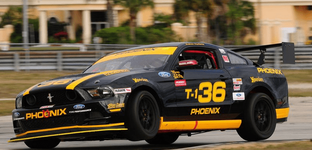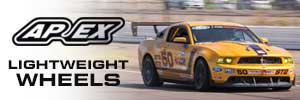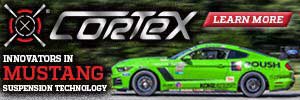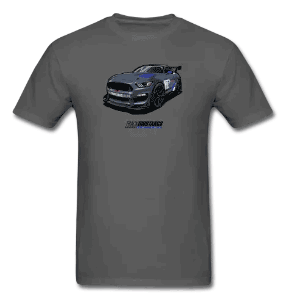- Welcome to the Ford Mustang forum built for owners of the Mustang GT350, BOSS 302, GT500, and all other S550, S197, SN95, Fox Body and older Mustangs set up for open track days, road racing, and/or autocross. Join our forum, interact with others, share your build, and help us strengthen this community!
You are using an out of date browser. It may not display this or other websites correctly.
You should upgrade or use an alternative browser.
You should upgrade or use an alternative browser.
Kenny Brown AGS 4.5: Have I Been Living Under A rock Or Is This Brand New?
- Thread starterSMGDHG
- Start date
This site may earn a commission from merchant affiliate links, including eBay, Amazon, and others.
More options
Who Replied?This photo doesn't really show anything with regard to spring rates. I'd be curious what spring rates Andrew runs on his car. I'll ask him.
On Edit: Andrew's front spring rates are pretty soft, but the front bar is very large. And that's evident in the photo posted.
Last edited:
Mad Hatter
Gotta go Faster
Good idea.
Mad Hatter
Gotta go Faster
But you can bet your bottom dollar its no where near 650 for the rear... more like 300 to 350. I would think that at 650 your going to have zero squat and not much traction.
With stock rear suspension geometry, 650 rear springs would be very high.But you can bet your bottom dollar its no where near 650 for the rear... more like 300 to 350. I would think that at 650 your going to have zero squat and not much traction.
But, spring, anti-roll bar, and roll center all play into lateral load transfer. If going from, say, 300 rear springs to 600 rear springs, the squat will not be "zero..."
...but it's going to be "half" of what it was with 300 rear springs...all other things being equal. The rate of rearward weight transfer will also be affected by front rebound and rear compression, ride height, and anti-squat geometry. The type of tires also matters...probably more than anything else. Stickier tires work better with higher spring rates.
The point is there are a lot of variables at play besides just spring rates. Ultimately, you need to focus on lap times. If you're faster than before, then you're going in the right direction.
Mad Hatter
Gotta go Faster
Thats very true... Spent a long time with #600/#350 springs with 315/30-18 R7's (square). After switching to #500/#300 the car became much more competitive and corner exit acceleration increased dramatically.
So Kenny Browns k-link has more to it than just the k-link to fully setup. In addition the the k-link is a u-link to replace the stock piece. Its supposed to reduce squat and lift and be beneficial to lowered cars. I have the full kit for the rear, and the front grip kit from KB. Im waiting for the coil overs still.
Banging my head against the wall trying to figure out where best to install a water temp sensor. Working on the front splitter this weekend, the wing is on and that makes me pretty happy . I clearanced the rear bumper platic and metal for a diffuser but I wont get to that until winter.
. I clearanced the rear bumper platic and metal for a diffuser but I wont get to that until winter.
Banging my head against the wall trying to figure out where best to install a water temp sensor. Working on the front splitter this weekend, the wing is on and that makes me pretty happy
Yes, the Mustang performance world lost a very special man! In spite of that Team KB continues to move forward with some very special projects on the board. Cheers!
Eibach Pro1 single adjustable struts (Discontinued), MMS camber plates. BMR K member, w/adjustable LWR arm. STD Boss 302 LS front bar, BMR sway bar urethane pillow blocks w/lube zerks.
Eibach Pro1 single adjustable struts (Discontinued), MMS camber plates. BMR K member, w/adjustable LWR arm. STD Boss 302 LS front bar, BMR sway bar urethane pillow blocks w/lube zerks., STD 4 puck Brembos, Girodisc floating rotors.
WesD,What's your front suspension setup (besides the 650 lb/in springs and LS sway bar)?
Eibach Pro1 single adjustable struts (Discontinued), MMS camber plates. BMR K member, w/adjustable LWR arm. STD Boss 302 LS front bar, BMR sway bar urethane pillow blocks w/lube zerks., STD 4 puck Brembos, Girodisc floating rotors.
Mad Hatter
Gotta go Faster
With those BMR K member and LWR ( lower control arms?). What tires are you going to run??
Fabman
Dances with Racecars
- 6,718
- 8,569
- Exp. Type
- W2W Racing
- Exp. Level
- 20+ Years
The latest KB ad claims "lower lap times by up to 11 seconds".
That's a pretty hefty claim right there....
That's a pretty hefty claim right there....
Yeah. In reading the fine print, it's *up to, and I think they're talking about going from OEM to full K-B suspension. Regardless, that's kinda weird marketing.The latest KB ad claims "lower lap times by up to 11 seconds".
That's a pretty hefty claim right there....
Well yeah, and if you're talking about a full lap of Nürburgring for sure I can see 11 seconds. HA!
Mad Hatter
Gotta go Faster
hmmm..... I think a 11 seconds gain is a bit optimistic even at Nürburgring.
Mad Hatter
Gotta go Faster
Not to be pessamistic, but most of us are pretty dam happy if we can get the car to be 1 second faster. Some major changes mean 2 seconds. But 11, that sounds like it was with two different drivers.
Agreed. Personally, I'm more interested in learning what actual customers think of it, and so far, the feedback seems to be overwhelmingly positive. I know many of us are happy with our current setups, but I think "don't knock it till you try it" certainly applies.Not to be pessamistic, but most of us are pretty dam happy if we can get the car to be 1 second faster. Some major changes mean 2 seconds. But 11, that sounds like it was with two different drivers.
Mad Hatter
Gotta go Faster
Tuned in! Let us know how it goes!
Fabman
Dances with Racecars
- 6,718
- 8,569
- Exp. Type
- W2W Racing
- Exp. Level
- 20+ Years
I've been a big proponent of low roll centers since the 70's, It makes tons of side bite. ( My stock car had a 6" rear roll center)
The down side is it also creates body roll and under steer....sooooo if you can manage the those characteristics you can indeed be fast, but you have to deal with that.
The part I have a problem with is the 650# rear springs. If you have to throw away traction to balance the car, have you really done anything?
Maybe the roll center didn't need to be THAT low....plus super stiff rear springs will sacrifice forward bite so if you're making any real power that's going to be an issue.
I am interested to see how this works out.
The down side is it also creates body roll and under steer....sooooo if you can manage the those characteristics you can indeed be fast, but you have to deal with that.
The part I have a problem with is the 650# rear springs. If you have to throw away traction to balance the car, have you really done anything?
Maybe the roll center didn't need to be THAT low....plus super stiff rear springs will sacrifice forward bite so if you're making any real power that's going to be an issue.
I am interested to see how this works out.
Agreed on all counts...at least in theory. What's weird: accounts of how this setup works on real cars leads me to believe there's more going on than we may realize. I'm growing more convinced that the extremely low roll center benefits a live axle car more than an IRS because live axles seem to be more sensitive to the jacking effect with above-ground roll centers. Maybe the corner exit bite from minimizing jacking the inside rear wheel outweighs the loss forward bite from stiff(er) rear springs. Going back to theory, however, if both rear wheels are more evenly loaded (from the low roll center), then the rear diff can be "looser," which also reduces understeer.I've been a big proponent of low roll centers since the 70's, It makes tons of side bite. ( My stock car had a 6" rear roll center)
The down side is it also creates body roll and under steer....sooooo if you can manage the those characteristics you can indeed be fast, but you have to deal with that.
The part I have a problem with is the 650# rear springs. If you have to throw away traction to balance the car, have you really done anything?
Maybe the roll center didn't need to be THAT low....plus super stiff rear springs will sacrifice forward bite so if you're making any real power that's going to be an issue.
I am interested to see how this works out.
All food for thought!
Fabman
Dances with Racecars
- 6,718
- 8,569
- Exp. Type
- W2W Racing
- Exp. Level
- 20+ Years
I look at it like;Agreed on all counts...at least in theory. What's weird: accounts of how this setup works on real cars leads me to believe there's more going on than we may realize. I'm growing more convinced that the extremely low roll center benefits a live axle car more than an IRS because live axles seem to be more sensitive to the jacking effect with above-ground roll centers. Maybe the corner exit bite from minimizing jacking the inside rear wheel outweighs the loss forward bite from stiff(er) rear springs. Going back to theory, however, if both rear wheels are more evenly loaded (from the low roll center), then the rear diff can be "looser," which also reduces understeer.
All food for thought!
Let the car rotate around the roll center without reducing load on the inside tire. This is why I don't typically run a rear sway bar. (never say never though)
Its job is to add load to the outside tire by taking it from the inside tire and adding that spring rate in with the total roll couple. Seems counter productive to me.
With a high roll center you share the load more equally but load transfer from body roll is expressed at the contact patch rather than around the roll center.
Too high and the car just skates. Others like big rear springs to keep a balanced chassis. But again, too much and it skates and as a nice bonus you sacrifice forward bite.
I like low roll centers and soft springs. I'll deal with the body roll and understeer as long as I continue to beat the next guy off the corner.
However, I continue to test and try different approaches and combinations in the quest for lower lap times....who knows what I might find.
And that's the fun of it....right?
Similar threads
- Replies
- 62
- Views
- 7K














